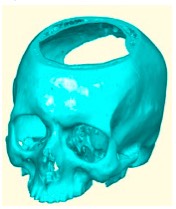VLFLofVMdelaunay
by Tim C. Lueth, SG-Lib Toolbox: SolidGeometry 5.6 - VM/Voxels
Introduced first in SolidGeometry 2.1, Creation date: 2015-01-20, Last change: 2025-09-14
returns a surface model for a delaunay reconstructed volume model
See Also: VLFLofVMdelaunay
, VLFLofVMmarchcube
, TR3ofVM
, SGofVMmarchcube
, SGofVMdelaunay
Example Illustration

Syntax
[VL,FL,TR4]=VLFLofVMdelaunay(V,[vs,s])
Input Parameter
V: | | Voxel Model (~=0 is reconstruction) |
vs: | | voxel size, optional |
s: | | step size |
Output Parameter
VL: | | Vertex list |
FL: | | Facet list |
TR4: | | Delaunay tetrahedron model |
Copyright 2015-2025 Tim C. Lueth. All rights reserved. The code is the property of Tim C. Lueth and may not be redistributed or modified without explicit written permission. This software may be used free of charge for academic research and teaching purposes only. Commercial use, redistribution, modification, or reverse engineering is strictly prohibited. Access to source code is restricted and granted only under specific agreements. For licensing inquiries or commercial use, please contact: Tim C. Lueth
Algorithm (Workflow)
This function, VLFLofVMdelaunay, reconstructs a surface model from a voxel model using Delaunay triangulation. It is part of the SG-Library and was developed by Tim Lueth in 2015.
Input Parameters
- V: The voxel model, where non-zero values indicate the presence of a structure to be reconstructed.
- vs: An optional parameter specifying the voxel size. If not provided, defaults to [1, 1, 1].
- s: The step size, which is optional. If provided, it scales the voxel size.
Output Results
- VL: The vertex list of the reconstructed surface.
- FL: The facet list, representing the surface facets.
- TR4: The Delaunay tetrahedron model.
Algorithm Steps
- Initialize
vs to [1, 1, 1]. If a voxel size is provided, update vs accordingly.
- Initialize
s to 1. If a step size is provided, update s and scale vs by s.
- Extract a vertex list
VL from the voxel model V using the step size s.
- Create a Delaunay triangulation
TR4 from the vertex list VL.
- Extract the points and connectivity list from
TR4.
- Initialize an array
isInterior to track interior tetrahedra.
- Iterate over each tetrahedron to determine if it is interior by checking the maximum edge length.
- Scale the vertex list
VL by the voxel size vs.
- Select only the interior tetrahedra and update
VL and TL.
- Create a new triangulation
TR4 with the updated vertex and connectivity lists.
- Extract the free boundary facets
FL from TR4.
- Select and update the vertex and facet lists.
- If no output arguments are specified, plot the surface model with Gouraud lighting.
Algorithm explaination created using ChatGPT on 2025-08-19 06:50. (Please note: No guarantee for the correctness of this explanation)
Last html export of this page out of FM database by TL: 2025-09-21